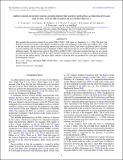IMPLICATIONS OF BURST OSCILLATIONS FROM THE SLOWLY ROTATING ACCRETING PULSAR IGR J17480–2446 IN THE GLOBULAR CLUSTER TERZAN 5
Author(s)
Cavecchi, Y.; Patruno, A.; Haskell, B.; Watts, A. L.; Levin, Y.; Linares, Manuel Alegret; Altamirano, D.; Wijnands, R.; van der Klis, M.; ... Show more Show less
DownloadCavecchi-2011-IMPLICATIONS OF BURS.pdf (377.2Kb)
PUBLISHER_POLICY
Publisher Policy
Article is made available in accordance with the publisher's policy and may be subject to US copyright law. Please refer to the publisher's site for terms of use.
Terms of use
Metadata
Show full item recordAbstract
The recently discovered accreting X-ray pulsar IGR J17480–2446 spins at a frequency of ~11 Hz. We show that Type I X-ray bursts from this source display oscillations at the same frequency as the stellar spin. IGR J17480–2446 is the first secure case of a slowly rotating neutron star (NS) which shows Type I burst oscillations (BOs), all other sources featuring such oscillations spin at hundreds of Hertz. This means that we can test BO models in a completely different regime. We explore the origin of Type I BOs in IGR J17480–2446 and conclude that they are not caused by global modes in the NS ocean. We also show that the Coriolis force is not able to confine an oscillation-producing hot spot on the stellar surface. The most likely scenario is that the BOs are produced by a hot spot confined by hydromagnetic stresses.
Date issued
2011-10Department
MIT Kavli Institute for Astrophysics and Space ResearchJournal
Astrophysical Journal
Publisher
Institute of Physics/American Astronomical Society
Citation
Cavecchi, Y., A. Patruno, B. Haskell, A. L. Watts, Y. Levin, M. Linares, D. Altamirano, R. Wijnands, and M. van der Klis. “IMPLICATIONS OF BURST OSCILLATIONS FROM THE SLOWLY ROTATING ACCRETING PULSAR IGR J17480–2446 IN THE GLOBULAR CLUSTER TERZAN 5.” The Astrophysical Journal 740, no. 1 (September 19, 2011): L8. © 2011 American Astronomical Society.
Version: Final published version
ISSN
2041-8205
2041-8213